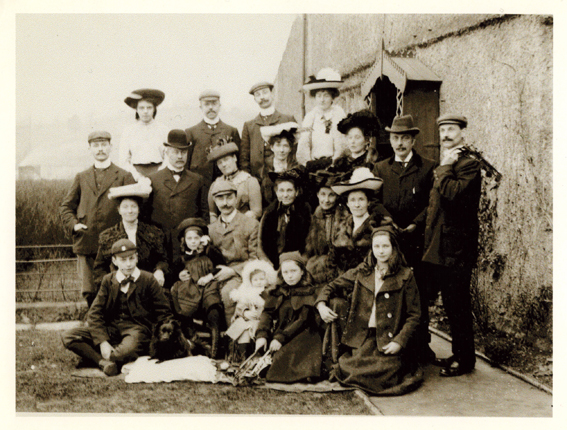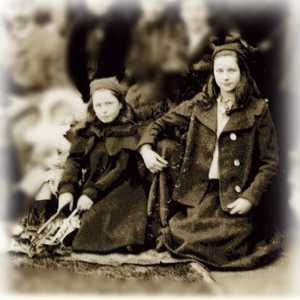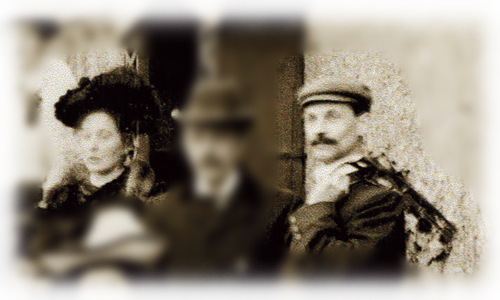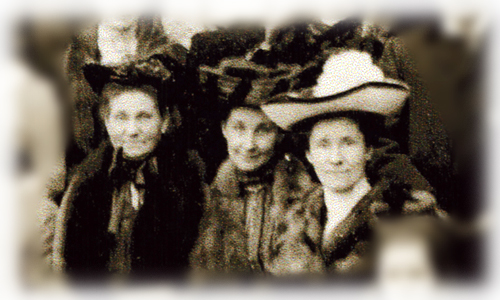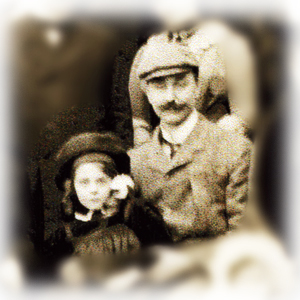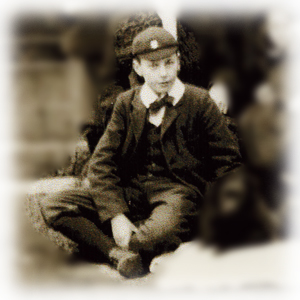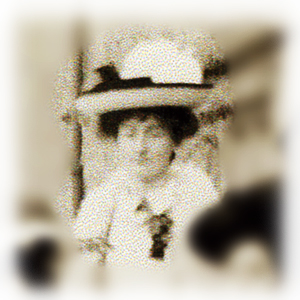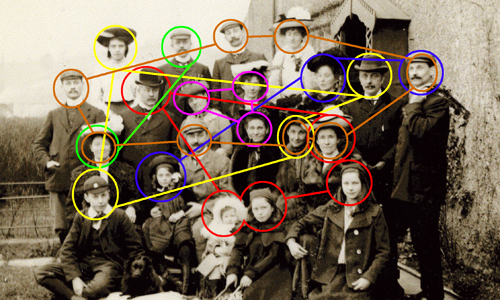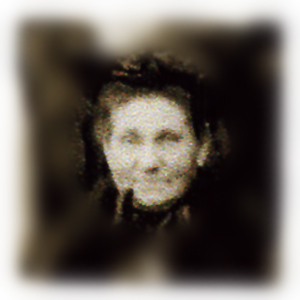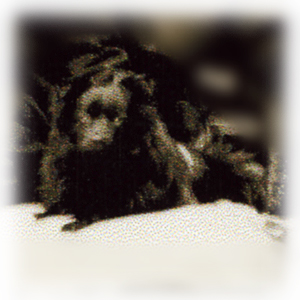The skating party is getting ready to leave. They’ve gathered outside the cottage before heading off, wrapped up against the morning cold. Some of them are wearing furs while others have on thick woollen coats and hats. Some of them are carrying their skates in readiness for the walk to the local pond. It’s a dreary mid-winter’s day. The hedgerows are bare and the lawn is dead and frost-bitten. The sun, which barely seems to make it above the horizon at this time of year, is hidden by overcast skies.
Before they leave, the party just has time for a photograph, a reminder of their holiday together. It’s a rare occasion for them all to be in the same place at the same time, a special moment that is worth recording. Who knows if and when they will all meet again? Maybe never. This is it.
They arrange themselves into a compact group, the children sitting on rugs on the ground, a row of adults seated behind them, then another row standing. Somebody has had the presence of mind to bring a bench out of the cottage so that some of the group can stand up at the back.
Did somebody decide where they would all stand and sit – maybe the photographer, busy behind his bellows and black-out cloth - or did they choose their own positions? At first glance, you might reasonably expect the married couples – there are four of them here, in case you were wondering – to arrange themselves in pairs. Perhaps the four people standing on the bench at the back are two married couples? It seems only natural that they would gravitate towards each other, drawn by bonds of love and matrimonial duty. Or what about the couple on the far left, the man standing and the woman seated in front of him? They must be husband and wife surely, staring unwaveringly into the lens together, the man with that peculiar way of putting his hand in his jacket pocket (fingers in, thumb out) that seems somehow so characteristic of the Victorian male. Does anybody stand like that these days?
Or what about the couple next to him, the man in the bowler hat that looks too small for his head and the woman alongside him, her head inclined slightly towards him, maybe as a gesture of instinctive devotion? Do they look like a likely couple? Would it surprise you to learn that this woman, believe or not, is more than 20 years older than the bowler-hatted chap? How difficult it is at this distance – I mean in time as well as focal length – to accurately judge the age of these people, even the children. They all just look, well, old-fashioned.
OK, you can stop speculating now. I know for a fact that none of the four married couples are standing together. They are all mixed up. Does that make your guessing game harder or easier? Hmmm? I admit it, I have something of an unfair advantage over you as I do know something about these people, who they are and what makes them remarkable, at least in my eyes.
Hats and taches
So, just to be fair, imagine for a moment that I know nothing about these people; what can we tell about them just by looking this photograph? Let’s detain them for just a little longer for an inspection before they troop off for their daily exercise, heading down the village high street to the frozen pond, and then slipping and sliding on the cold, hard ice, the girls screaming and holding on to each other to keep themselves from falling over, the younger children clinging to their parents’ legs. Perhaps on the ice the couples will reform into their correct pairings, guiding each other by the hand round and round in a sedate pas de deux.
Well, we can see there are 21 people here, 8 male and 13 female, 15 adults and 6 children. Everybody is wearing a hat of some sort. There are 6 caps and 9 bonnets. Every man has a moustache. That in itself seems remarkable to me, living as I do in an age when the male moustache has become largely an object of derision or camp irony, something that men will grow for charity or to win a bet, but not because that’s simply what one does.
No-one is smiling. No-one is saying ‘Cheese!’. Maybe there is a slight grin somewhere, not much more than a grimace. That’s the best we get. This is a serious business. Photographs require decorum, not frivolity, as befits the importance of the occasion.
Having said that, it’s clear that not everybody has their mind on the task at hand. While most stare fixedly ahead, somewhat morosely, into the lens, at the last moment something seems to have distracted the children. Instead of looking directly at the camera, they appear to be looking slightly to one side. Perhaps they are looking at the photographer, standing beside the camera as he removes the lens cap with a flourish, their eyes drawn to his antics like watching a magician perform his next trick.
The children are not alone in being distracted however. At the same time as the two girls at the front, both wearing plain caps like something out of Swallows and Amazons, are looking off to the side, the man in the small bowler hat seems to be looking at them, perhaps checking to see if they are behaving themselves. Does that give you a clue? That’s right: he is their father.
The man standing on the far right with his skates slung nonchalantly over his shoulder also seems to be gazing off into the distance. Perhaps he has seen something coming towards the cottage along the main street that leads out of the village. Maybe it’s the horse-drawn wagon that leaves every week to take the local farmers and their wives to market at the nearby town.
Whatever it is that is more captivating for the man at this moment, he shares his divided attention with the woman standing two places along who seems to be similarly distracted, her face blurred by a sudden, last-second movement. Together, they appear to stare off to the side, their gazes pulled together by something off-camera. Does that give you another clue? Correct again, they are one of the couples in this photograph, united forever in this instant by their distraction.
Focus. Lack of focus. United and divided. How hard it is to bring such a group of people together at the same time, drawn from different parts of the country, and indeed from around the world, to share this moment. How many paths lead to this small patch of garden on an English winter’s day?
By now you’ve probably worked out what it is that binds them together, the ties that tug and tangle and stretch and sometimes break. They are a family. Can you spot the physical similarities? Surely those three women seated in a row with furs draped around their shoulders are related, with their common chin, the same intent look and faintly quizzical smile?
Everybody in this photograph is related to each other either by blood or marriage. We know already that the two Amazon girls are sisters; the third sibling in that family is the little girl next to them, peering out from underneath her fluffy white hood like a small baby-faced yeti.
In fact there are three different sets of sisters assembled here, 11 sisters in total. There are five brothers and five sons (OK, I realise that every male is a son of someone, but I mean in the sense that their mothers are here too; they are here, in part, as sons). There are also nine daughters, four mothers and three fathers, not counting the ones who don’t yet realise what little bundles of joy lie ahead for them. Cousins? About half a dozen or so including two, several times removed, who are married to each other. Uncles and aunts? Well, maybe I’ll leave that calculation for another time, perhaps for a rainy day when I’ve finished my tax return and still feel the need to do some more adding up.
In short, there are four different families here (as comprising two generations, parent and offspring) and three generations of the same family. The oldest was born in 1844 and the youngest died in 1988; collectively, their lives span nearly 150 years of history from early Victorian England onwards, their own stories shaped and touched by some of the major events and movements of that period.
It perhaps comes as no great surprise to learn that this is my family, or rather they are my distant relatives, some of them many times removed, so to speak, but all linked and intertwined, traceable via various lines and genealogies. My grandmother, my great grandmother and my great great grandmother are all in this photograph. There are three people here of whom I have quite distinct – if possibly erroneous – memories.
It’s about time we gave this family a name so we’ll call them the Talents, because that is what most of them are. There are eight Talent siblings here, four boys, four girls, and they form the core of this group, the trunk from which everything else branches off.
We’ll get to know the Talents a little better in due course and I’ll tell what I know about them. If you don’t feel like meeting the family at this stage – and I quite understand what it’s like being introduced to other people’s relatives, trying to remember their names and who they all are – please feel free to wander off at this stage (perhaps take a stroll around the garden) but be sure to come back later when we’ll be visiting some rather interesting places.
Meet the Talents
The eldest of the Talent children is John. That’s him sitting in the middle with the little girl on his knee. The little girl is Louie, his niece. John is a doctor with a practice in Ashton-under-Lyne near Manchester in England. At the time of this photograph, he is in his early forties and still a bachelor, although he will marry in a few years time and have two children of his own. We know something about him because my grandmother – that’s her, the smaller of the two Amazons sitting down at the front holding the skates – recalled visiting him at his house in Ashton-under-Lyne at about the time this photograph was taken. Uncle John, it turns out, was not her favourite uncle.
I never liked going to his house, because he had a monkey that always sat on the top of the oven, and was very mischievous and used to pull our hair and run off with our toys.
I look at that moustache, evocative perhaps of Hardy’s Alex D’Uberville, and wonder if it is the moustache of a man (a medical man no less) who would let a monkey run wild in his kitchen, pulling at the hair of little girls.
The next Talent is Jane. She is sitting two places along on John’s left, the middle one of the three women in fur. She’s married to Arnold Yoxall, the rather dapper looking gentleman in the homburg hat standing next to our distracted skater. The Yoxalls also live in Ashton-under-Lyne where Arnold is the manager of a cotton mill. Their children are Arthur, the boy in the cap sitting down at the front, and Evelyn, the young woman standing at the back on the far left.
Arthur is one of the people from the photograph I can remember. Uncle Arthur we used to call him although, in truth, he was my grandmother’s cousin, so I don’t know what that makes him to me. He always seemed like the archetypal uncle, the sort of man for whom the word avuncular was coined. A big, jolly man, he drove a large Daimler motor car in a rather sedately manner, as I recall. Whenever he was driving along and he saw workmen mending the road, he liked to roll down his window and wish them a cheery “Good morning!” You don’t see that too often these days.
Sitting next to Jane on the end of the row is her younger sister, Emily, although everybody knows her as Gertie after her second name, Gertrude. She is my great grandmother and the three girls sitting in front of her, the two Amazons and the baby-faced yeti, are her daughters, Hilda, Doris and Gladys, in descending order. And as you’ve probably worked out by now, being so quick on the uptake, Gertie is married to the bowler-hatted gentleman who is keeping a watchful eye on the girls. That’s Dr Fred Marshall, another doctor. The Marshalls – Dr Fred, Gertie and the three girls - have just returned from South Africa where Dr Fred had a practice with the De Beers mining company.
In fact, Dr John and Dr Fred share something in common in that they both studied medicine at Edinburgh University in the 1890s. Immediately, a small germ of an idea takes hold, of two medical students from the same part of the world – John from Lancashire and Fred from Staffordshire – sharing lecture notes at the most prestigious teaching hospital in the world. ‘Why don’t you come and visit us during the vacation?’ says one to the other, ‘You must meet my sister…’
From such beginnings, many things can flow – including me, in a sense, given that without Fred and Gertie there would be no Amazon Doris, and without Doris I would have no grandmother and no mother, and so on…
At the other end of the row is Beatrice Talent, the third of the sisters. She is married to Charlie Gray, a commercial clerk from Manchester, who is standing next to Evelyn Yoxall on the back row. Next to him is another Charlie and another Talent, also from Manchester and unmarried at this time, and next to him is his younger sister, Ethel Talent, also known as Winnie, who is also unmarried. Both of them would later marry and have families of their own. In fact, Winnie married a local painter and decorator from the village.
Winnie is the youngest of the Talent siblings and the only one I remember. She was born in 1876 and when I met her she was in her nineties, still bright and lively like a wrinkled old pixie, still living in the same village, Grewelthorpe in Yorkshire, where this photograph was taken.
Moving on, Harry Talent is our distracted skater, and his similarly distracted wife is Florence: that’s their daughter, Louie, sitting on Dr John’s knee. That just leaves Alex Talent, the gentleman with his hand in his jacket pocket, who never married and lived in South Africa for much of his life.
So you see how the mosaic fits together, the brothers and sisters, sons and daughters, husbands and wives, the pattern of carefully (or randomly?) arranged faces linked by lineage and love. John, Jane, Gertie, Beatrice, Harry, Charlie, Alex and Winnie – all the Talent children born between 1863 and 1876. Most of them went on to live long lives too: Winnie until she was 95, John and Harry who reached 89, Alex to 84 and Jane to 82. That’s not all the Talents either, there are two missing from this photograph: Sarah, the fourth eldest who had died a few years earlier aged 28, and Frank who was off fighting the Boer War in South Africa at the time of this photograph.
Ten children in total and at the centre of them all – right in the middle of the photograph - is the matriarch, Sarah Talent, my great great grandmother. There she sits, squeezed in between her two eldest children, Dr John and Jane, surrounded by her family and peering out at us, looking slightly amused by the moment or perhaps a little pensive.
When this photograph was taken, Sarah had just turned 60 years old and her husband, John, had been dead for 10 years. She was living in this cottage with her sisters, Martha and Helen, the two women standing behind her.
It is Sarah who is at the heart of the picture and the family, the figure that links all these people together, those who have travelled from overseas and those who have come over the Pennines from Manchester to visit her in Yorkshire.
It’s a journey I have done myself many times, flying into Manchester airport and driving across the Pennines to visit my parents in Yorkshire, just down the road from where this photo was taken over 100 years ago. Back then, of course, cars were a rarity and planes were just beginning to get off the ground. Did they all come for just a day visit or to stay longer? And did they ever meet up again for a moment like this, frozen in time and place? Did they wonder then how unique this blink of the shutter would be before they dispersed once again and the flow of time resumed like somebody pressing ‘Play’?
We’ll let them go and play in a moment, but first there’s something that’s puzzling me about this picture. I grew up in a village not far from Grewelthorpe and although the winters were cold and icy, and it snowed regularly, they were never cold enough to freeze the local pond sufficiently for us to go skating on it. None of us, as kids, had skates and the thought of looking for somewhere to go skating would never have occurred to us. It was never that cold. This suggests that it must have been a lot colder 100 years ago for anybody to be able to venture out on the ice with confidence.
But if it really was that cold for the people in the photograph, as they huddle together in a group, holding their pose for the camera and trying to stifle a shiver, then it seems to me that some of them are seriously under-dressed. There is fur and hats but none of them appear to be particularly rugged up. Young Evelyn Yoxall, for instance, seems to be standing there in nothing more than a long sleeve blouse, hardly the right attire for sub-zero conditions.
I know this photograph was taken some time after the Marshall family returned from South Africa and before they left for China in March 1905, so it was likely taken during the winter of 1904-05 (which, to be precise, makes them Edwardian, not Victorian). At the time, the Marshalls – Dr Fred and Gertie, the two Amazons, Hilda who was 12 years old and Doris who was 10, and little Gladys, the baby-face yeti, who was 2 – were staying in the cottage next door to the one occupied by Sarah and her sisters. Before she died in 1974, my grandmother, Doris, remembered what it was like living there:
We spent many happy times here, and the country life was always a novelty to us. I remember at that time there was not running water in the cottages, and we had to take buckets or jugs across the road to a pump. This was the biggest treat to Hilda and myself, who had never seen a pump before. Eventually it was replaced by a tap, and later on water was put into the cottages, but only cold water so far. Water was heated in a boiler at the side of the fire, and had to be carried to the back kitchen for washing up etc. There was no bathroom so a bath was put in the kitchen by the fire for anyone, children and adults to use. Then the bath water had to be emptied down a drain outside. What a job but that’s how you had your bath!
We all thought the world of Granny, to whom no amount of hard work was any trouble, so long as she was making everyone happy. I can still see her with her old fashioned sun bonnet, busy in her garden, or feeding her hens, and I don’t remember her ever having help from outsiders. The winters there were very keen, being very high up, and I remember us having to break the ice upstairs for washing.
So if the winters were indeed “very keen”, cold enough for the water in the basin upstairs to freeze, then perhaps it is not too fanciful to imagine the local pond becoming a skating rink as well. Indeed, some records suggest that this was one of the coldest winters in England with record low temperatures during November and December.
Time to go
Let’s not detain them any further. They’ve been very patient posing for us but it’s time to release them now and send them on their way. We can watch from a distance as they head off down the street towards the village pond. See how carefully they step out onto the ice, arms flung out wide for balance as they tip-toe across the frozen surface. Or maybe they glide by gracefully, circling in ever-wider arcs as the lines drawn by their skates criss-cross, their paths intersecting and diverging, coming together and parting again.
But what’s that you say? You think I’ve forgotten something. There’s somebody in the photograph I’ve overlooked? Let’s rewind and have another look. Everybody accounted for, more or less, tallied up in the Births, Deaths and Marriages, albeit with some blanks in between and the details of the quotidian that fade into the misty background.
The dog? You think I’ve overlooked the dog, sitting there on the ground next to Uncle Arthur who looks as if he might be holding it down to stop it from skipping away. Even the dog is intent on the camera though, ears cocked, eager to play its part. Was he living in the cottage or was he visiting with one of the relatives, perhaps the animal-loving Dr John? I can’t say for sure but perhaps there’s a clue in a story told by my grandmother about their days living at Grewelthorpe:
Every Thursday was market day in Ripon (and still is) and an open wagonette with 2 horses used to go from Grewelthorpe to Ripon market. All the farmers and their wives too, big baskets of eggs and butter, and fowls, some alive to sell.
This was our treat of the week, and the wagonette was always packed to overflowing.
We always got a seat, because the owner came from the village shop next door but one to us, so we had the choice of the best seat at the front, and if we, Hilda and I, were lucky we got a seat with the driver. The wagonette held about 20, I would think, and all the farm produce was carried under the wagonette on a carrier. Summer and winter in all weathers the farmers and wives set off with their produce, and came home for tea laden with shopping they had done in Ripon. It was good fun for all who liked it, and we certainly did, though we didn’t go every week by any means.
There is one big hill between Ripon and Grewelthorpe coming home, where all except the aged had to get out and walk, so that the horses could get up to the top. I never fancied this part as a child, being tired after a day’s shopping.
It is 7 miles from Ripon to Grewelthorpe, but Father used to enjoy the cycle ride, and a visit to town where he had some friends.
I remember one day very well when he had been to do some buying and brought home some lovely steak for next day’s dinner.
When he got back Hilda and I were in bed, and Mother was at Granny’s. He put the parcel of meat on the table to go into Granny’s and left the door open, and when he got back the dog had been in and walked off with the lot. Poor Dad, he never forgot that!
So there you have it. Even the dog gets a walk-on, walk-off part in this history, gone but not forgotten.
